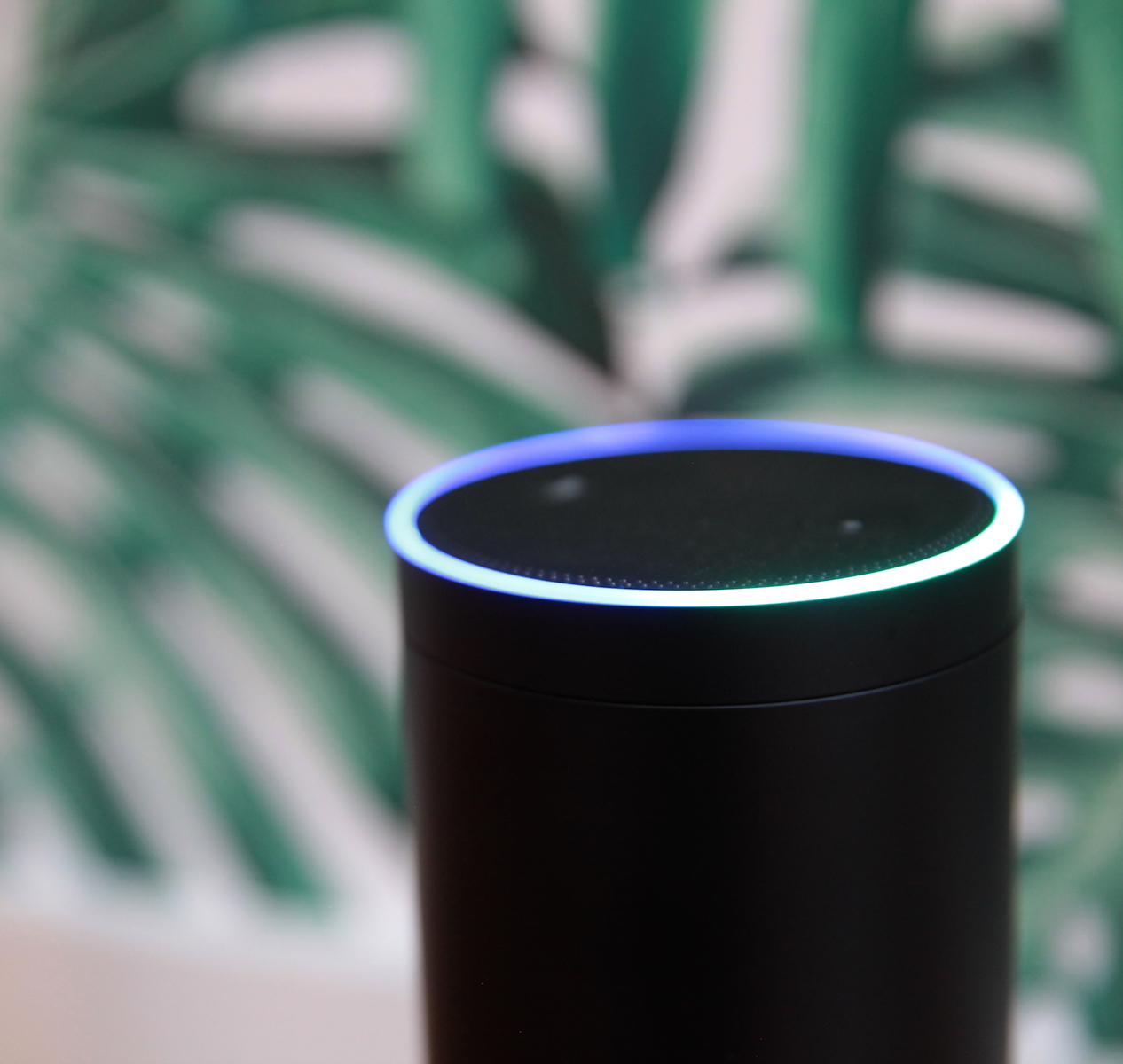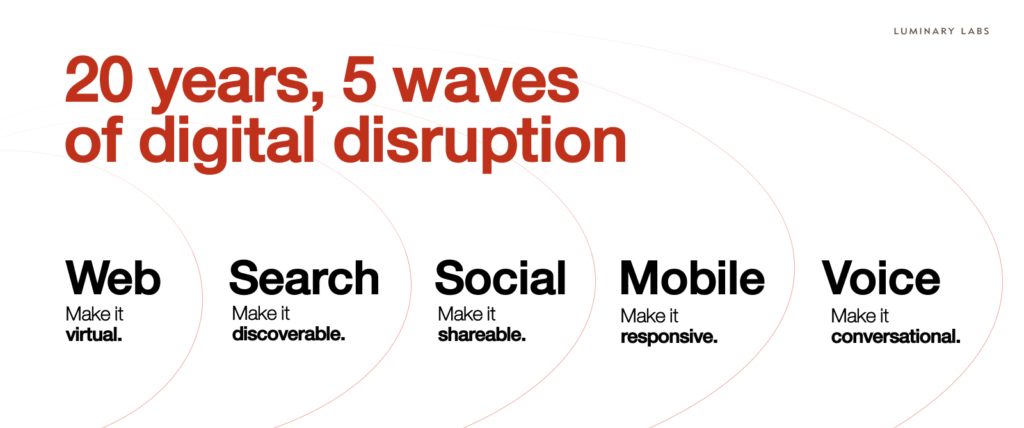A note from the editor:
Earlier this year, an Adobe survey found that nine in 10 business leaders surveyed by Adobe said they were investing in voice-enabled experiences. If you’re planning to prototype or pilot a voice application, you’re not alone. That’s why we’ve compiled recent data on the current state of voice tech and updated our most-viewed articles.
Here’s a look at what has — and hasn’t — changed since we published our first insights on voice technology in 2017. For our latest thinking on emerging technology and its potential to solve the problems that matter, subscribe to the Lab Report.
Update: October 10, 2019
This year, nearly 112 million Americans will use a voice assistant at least monthly, up from 35 million in 2017. Amazon Alexa has 100,000 skills now, up from 15,000 two years ago.
Smart speaker shipments reached 78 million in 2018, up 125% from nearly 35 million in 2017. In the first half of this year, high demand in China pushed global smart speaker shipments to nearly 47 million.
In the United States, one in five adults (around 53 million people) own a smart speaker, and more than half of those households have more than one device — which is why growth in shipments is outpacing growth in the adoption rate. U.S. smart speaker market share is largely unchanged, with Amazon at 70%, Google at 25%, and Apple at 5%.
Analysts are seeing some signs of slowing growth in adoption, and 43% of Americans who don’t own a smart speaker have no interest in getting one. Concerns over privacy and security top the list of reasons why people don’t own smart speakers.
Of course, voice interfaces aren’t limited to smart speakers. One-third of Americans are using a voice assistant at least monthly. Globally, Juniper Research estimates there will be 8 billion digital voice assistants in use by 2023, up from the 2.5 billion assistants in use at the end of 2018. The majority of those assistants will live on smartphones, and the firm predicts that the fastest-growing category for voice over the next several years will be smart TVs, not smart speakers.
Voice and screen combinations — hailed as “the future of digital experiences” — could enable more complex tasks and make voice technology useful across a broader range of activities. (Amazon Alexa is already HIPAA compliant and has potential for use in clinical settings.) Today, just 3% of employee interactions with workplace applications use voice interfaces, but Gartner predicts that will jump to 25% by 2023. The popularity of smart speakers in the home, combined with increasing accuracy and ease of use, could accelerate workplace adoption of voice technology.
Originally published February 8, 2018
We spent a lot of time with Alexa and Google last year, and we weren’t the only ones joining the voice technology conversation. U.S. smart speaker sales doubled in 2017, according to Adobe. Globally, an estimated 35 million smart speakers shipped in 2017, and Canalys expects more than 56 million to ship this year. And we’re doing more than playing music and checking the weather; more than one in five people with a smart speaker have used voice to shop.
What’s in store for 2018? Accelerating adoption rates are virtually guaranteed. The platform wars are heating up, and Apple’s delayed entry into the device market is expected to add more drama. Meanwhile, an onslaught of new appliances and IoT devices are adding voice assistants, bringing this new type of interaction to different contexts. Applications range from entertainment to v-commerce to enterprise across nearly every industry.
The speed of change — in both adoption rate and tech advancement — is making many executives feel anxious about jumping on voice, especially if digital transformation efforts have been limited to organizing around previous disruptions. It’s difficult to seize future opportunities if you’re still trying to recover from problems of the past.
The voice-first paradigm shift requires rethinking everything. But the challenge isn’t new — we’ve been through this before.
With each wave of disruption, companies have looked to external partners to help them understand the opportunity and make early bets. As the tech matures, companies develop internal competencies. Today, you have an agency — but you’re also likely to have reorganized and hired full time staff dedicated to SEO, social, and mobile. You’ve probably also developed the infrastructure and policies to move smarter and quicker. In a few years, the same will be true for voice technology.
A few months ago, we made a list of cottage industries that are likely to make an appearance this year. An explosion of pilots and larger-scale initiatives will fuel growth for a new set of service providers — and we expect a boom to be followed by a talent acquisition spree as the large agencies and consultancies scramble to demonstrate expertise. In the interim, expect pitches from the following this year:
- Voice development shops – At some point this year, your company will be pitched by a developer who built a skill, and now wants to build one for your company. These offerings are likely to be characterized by terrible voice interface design (VUI) and voice user experience (VUX) at first — but will become more sophisticated over time, especially if they’re working alongside …
- Voice design agencies – Companies like Opearlo are early to this space and are introducing conversational design across all voice assistant platforms. Meanwhile, corporations like JPMorgan Chase are naming agencies of record for voice marketing. Larger design firms and advertising conglomerates will look to build expertise in-house or — even more likely — acquire voice design startups.
- Voice analytics – Adobe has already added voice to their analytics tool, and others will show up to measure engagement. (If you thought attribution was a problem before, voice will add even more complexity.)
- Voice commerce – All those shopping cart experts have a lot of work to do. Some will go deep on Amazon Alexa; others will help retailers and brands compete with the e-commerce giant by developing shopping experiences for alternative platforms. Voicelabs’ Alpine is already translating retail websites into voice-first shopping experiences for both Alexa and Google Assistant. V-commerce startups are another likely acquisition target.
- Enterprise voice – While we all spin our wheels trying to win over customers with voice experiences, a startup will emerge to focus on internal uses for voice-first technology and AI. Voice technology has long been used in warehouses, and recent advancements have made hands-free devices even more useful for improving safety and efficiency in manufacturing and distribution centers. Consider the value to recruiting, where voice-enabled AI can help recruiters parse résumés. Voice has enormous potential to remove friction from information searches and database queries.
- Voice risk mitigation – Shortly after the first big lawsuit, there will be lawyers who know the ins-and-outs of voice platforms — and they’ll be more than happy to share their opinions on television.
- Voice compliance experts – They know the regulations, and will work with your voice lawyers. For regulated industries, someone will write voice marketing guidelines. Companies like Orbita are already working with healthcare and pharmaceutical companies to launch HIPAA-compliant voice solutions.
- Voice sentiment analysis – It begins, of course, with “voice listening” — think social listening, but literally listening to users. The applications go beyond consumer research; audio data from voice-enabled devices could be a new frontier for the healthcare industry in its search for digital biomarkers.
- Voice security – Because if they can hack it, they will. As our use of voice becomes more transactional and we share more personal data, there will be an increasing need to protect customers and companies from security threats.
So what is old is new again.
But here’s where voice presents a new opportunity: each digital disruption has prompted questions about content, interfaces, and data — the way we think about these elements has changed before, and it will change again. Sometime in the next five years, you’ll have to rethink everything in response to a digital disruption we can’t predict today. Rather than organizing around voice, consider this an opportunity to organize around learning. Or better, learning to learn.
If you’re ready to get started, share this explainer with your team:
The Lab Report helps executives make sense of emerging trends and new opportunities. Sign up for the newsletter, and we’ll send insights straight to your inbox.




